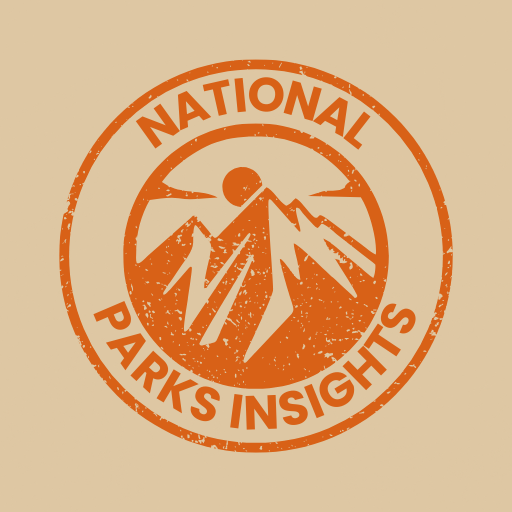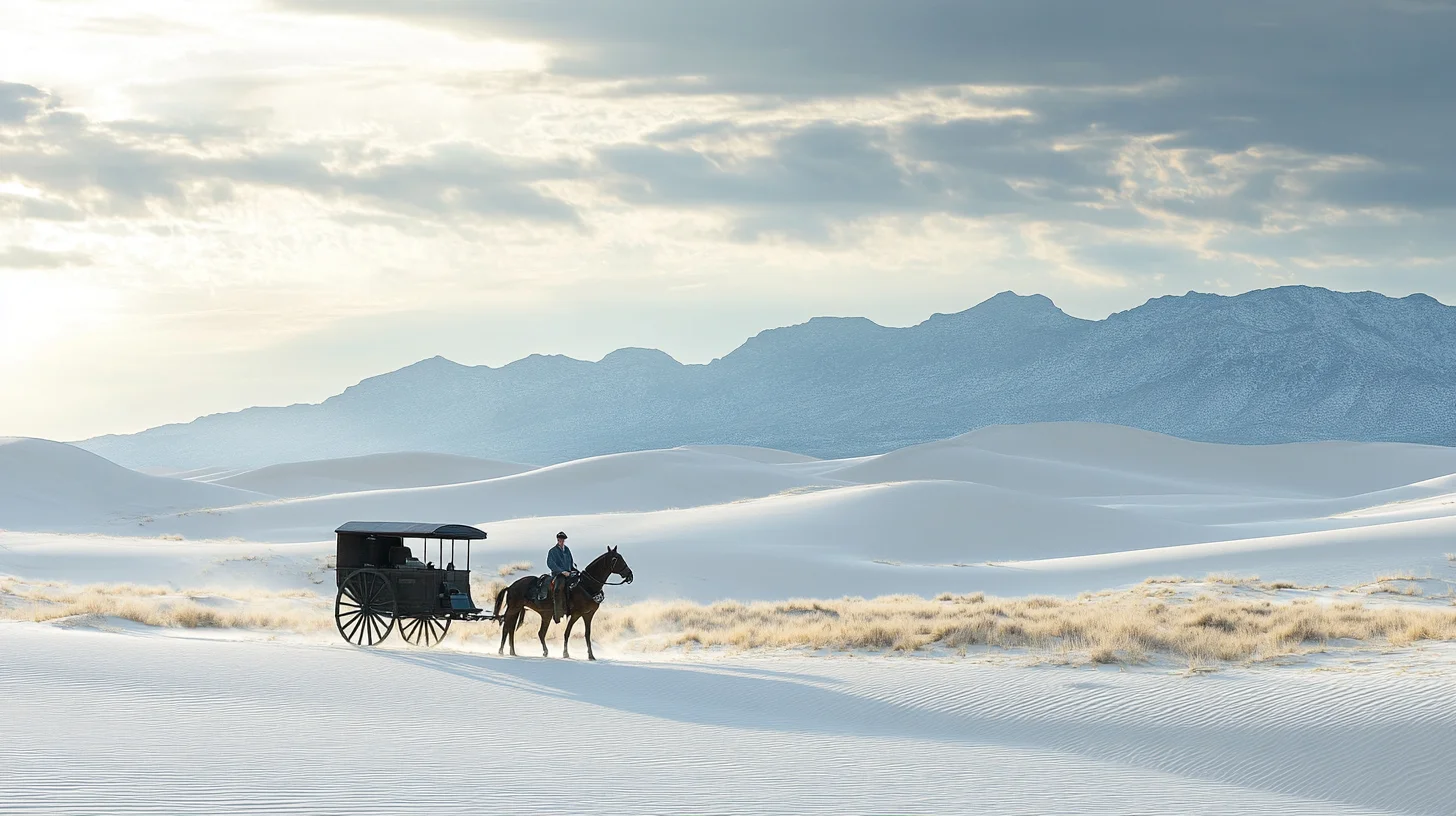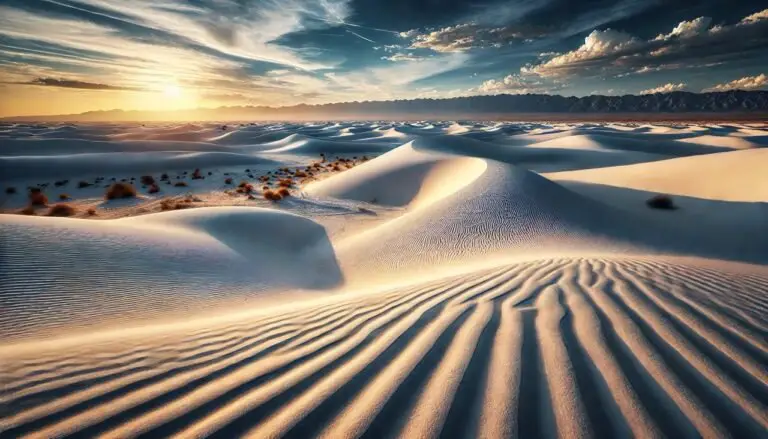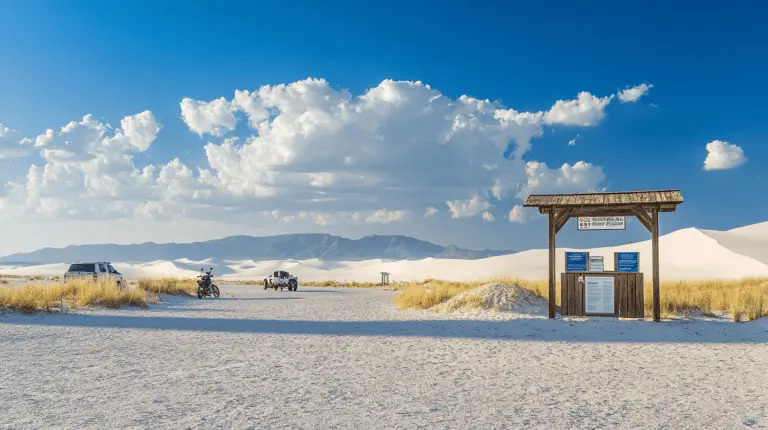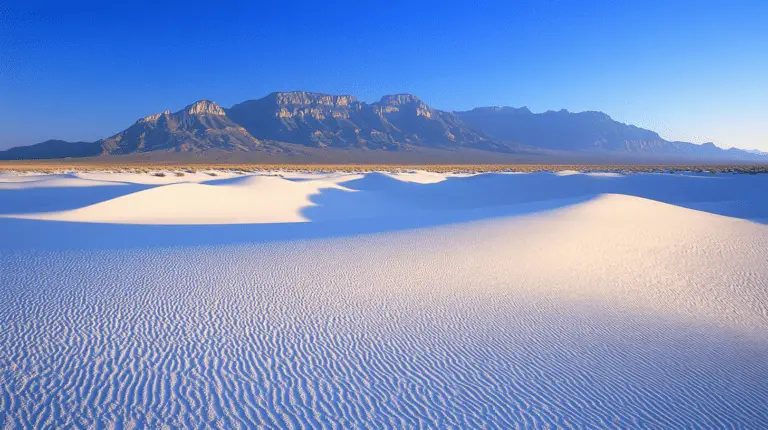White Sands National Park History: A Dazzling Desert Gem
What’s Behind the White Sands?

Ever wonder why White Sands National Park is a sea of shimmering white? It’s all about the gypsum. Unlike your run-of-the-mill beach sand which is made of quartz, these dunes are pure gypsum crystals. Ages ago, the area was underwater, part of an ancient sea. When the sea dried up, it left behind heaps of gypsum. Over thousands of years, winds chipped away at the gypsum, creating the fine, white sand we see today. It’s like nature’s giant sandbox, and it’s utterly beautiful.
The Hidden Role of Groundwater
You wouldn’t guess it by just looking, but groundwater is the unsung hero keeping White Sands’ dunes in check. Since 2009, teams from the University of New Mexico and the United States Geologic Survey have been diving into the mysteries of this hidden water. Their research shows that the groundwater stabilizes the dunes. It’s all part of a larger story involving regional water tables and climate patterns.
This research might sound nerdy, but it has real-life implications. Understanding how groundwater levels shift helps the park plan for climate change and manage its resources. It’s the behind-the-scenes stuff that makes a trip to White Sands more than just a walk in the park.
Planning Your Visit
If you love science and natural wonders, White Sands has your name written all over it. Head to the Visitor Center to dive deeper into the research—it’s like backstage access to the park’s secrets. And don’t forget to grab a map to make sure you hit all the must-see spots.
So pack your bag and get ready for a unique adventure. White Sands National Park isn’t just eye candy; it’s a place where natural beauty and science come together in the most amazing way.
Enjoy the view, marvel at the science, and take a lot of pictures. This place is truly one of a kind.
Discover Science Magic at White Sands
White Sands National Park isn’t just a pretty postcard—it’s a living, breathing science lab. Dive into the secrets of dune dances, mysterious lakes, and quirky critters with our quick and lively tour through the park’s latest research.
Dune Formation and Movement
White Sands is famous for its rolling sea of white dunes. Dr. Ryan Ewing from Texas A&M University uses high-tech gadgets like LiDAR and weather stations to crack the code on these shifting sands (National Park Service). Here’s what he’s found:
- Dune Babies: New dunes start off as tiny bumps called dome dunes or protodunes if you’re fancy.
- Crazy Shapes: The wind shapes these dunes into wild forms.
- Speed Demons: Tracking dune movement helps keep park paths clear and safe.
Curious? Swing by our white sands dunes page to see some of these natural wonders up close.
Mystical Lake System
The park’s modern lakes come with their own set of secrets. Dr. Kathy Benison from West Virginia University is on the case, digging into what makes these waters tick (National Park Service). Here’s what she and her team found out:
| Topic | Discovery |
|---|---|
| Gypsum Magic | The lakes keep creating new gypsum, feeding the dunes |
| Sand Source | Non-stop new sand supply for the dunes |
Want to play map detective? Check out the white sands national park map to pinpoint these lakes and more.
Wild and Wonderful Biology

The park’s creatures and plants are stars in their own right. Researchers from Princeton, New Mexico State University, the University of New Mexico, and the National Park Service are all part of the team. They’re looking into:
- Survivors: How animals and plants adapt to the harsh conditions.
- Home Sweet Home: Mapping the habitats of different species.
Get the scoop on which plants and animals call White Sands home by visiting our pages on white sands national park plants and white sands national park animals.
The science happening at White Sands National Park helps us see beyond the stunning scenery. Next time you visit, take a moment to appreciate the research and discoveries that add depth to these landscapes. Need more tips for your trip? Head over to the white sands national park visitor center for the latest info.
Why White Sands is a Big Deal
From Picnic Spot to National Monument
Back in 1933, President Herbert Hoover declared White Sands a national monument. This meant setting aside 142,987 acres because the place was just that awesome for its sights and science-y stuff. Before that, folks loved to picnic there, and it became a bit of a hangout. When they opened the monument on April 29, 1934, a whopping 4,000 people showed up! Not bad for a first day, huh? By the end of that first year, 34,000 visitors had checked it out.
Leveled Up to National Park Status
Fast forward to 2019, and President Donald Trump signed off on making White Sands a national park, part of the Fiscal Year 2020 National Defense Authorization Act. This bumped it up to National Park number 62. What does this mean? More moolah and resources to keep the park looking good and protect all the cool natural and historical aspects.
Military Buddies
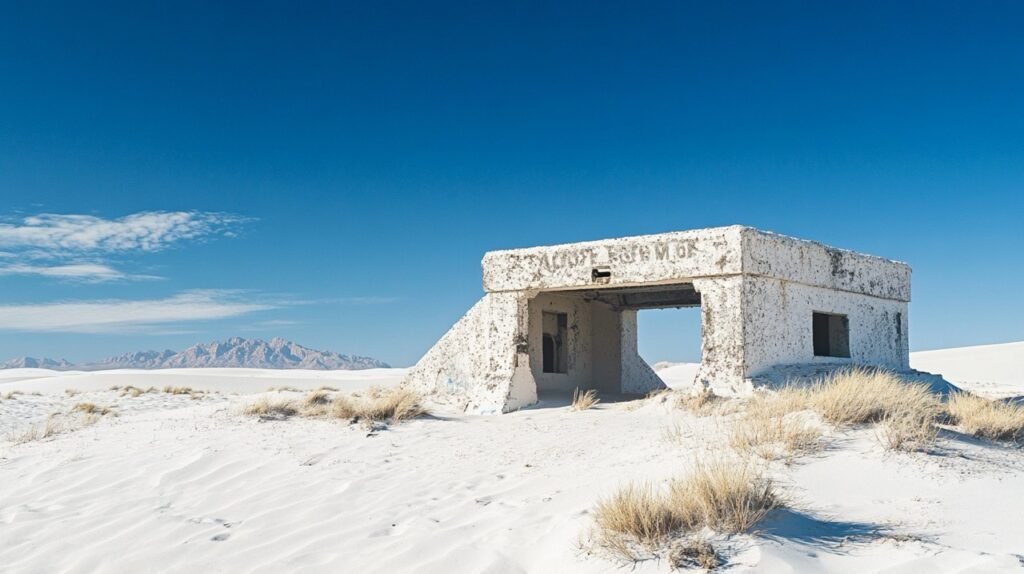
White Sands Proving Ground—now called White Sands Missile Range—got going in 1945. The military and the park have pretty much teamed up ever since. This partnership keeps the land safe from developers and makes sure that both the army and the environment folks are happy. If you’re into the military angle, check out more on our White Sands Missile Range page.
If you want the full scoop on how White Sands went from being just some land to a full-blown national park, hit up our White Sands National Park page.
Construction and Visitor Spots
Building Visitor Spots
White Sands, even before it became a national monument, was a hot favorite for picnics. On April 29, 1934, more than 4,000 folks showed up on its first day as a designated site, screaming for some proper visitor amenities. Visitor numbers soared to around 34,000 by the end of the first year, pushing for the creation of much-needed facilities.
| Facility | Year of Completion |
|---|---|
| Visitor Center | 1938 |
| Restrooms | 1935 |
| Residences for Park Staff | 1938 |
| Administration Building | 1938 |
| Maintenance Shed | 1938 |
These spots were set up to make sure visitors had access to water, restrooms, and the cool lowdown on the dunes’ history and formation. The visitor center is a must-stop for anyone wanting to dive into the captivating history and stunning geology of White Sands.
Big Help from the WPA
The Works Progress Administration (WPA) rolled up its sleeves to help build White Sands National Monument’s infrastructure. Part of President Roosevelt’s New Deal, the WPA dished out funds and manpower. From 1935 to 1938, they put up several buildings including the visitor center, restrooms, staff homes, and more.
Thanks to the WPA, the park got the foundation it needed to welcome an ever-growing number of visitors. This not only helped the park but also played into the wider national efforts to create jobs and public projects during tough times.
Even today, visitors benefit from WPA-built facilities which offer a sneak peek into the park’s past. You can do everything from joining guided tours to wandering through the rich plant and animal life that thrives here. To get the most out of your visit, don’t miss hitting the visitor center for exhibits and info.
In short, the creation of visitor facilities and the WPA’s support have been key in making White Sands National Park a fun and educational spot for everyone. Exploring these spots gives you a better feel and respect for the park’s historical importance.
Want to know more? Check out:
- White Sands National Park hours
- White Sands National Park map
- White Sands National Park entrance fee
Indigenous Presence at White Sands
White Sands National Park is a place where history and nature come together. For thousands of years, various Indigenous groups have called this land home. Let’s explore their fascinating stories and lasting impact.
Early Native Visitors
Some 23,000 years ago, ancient Indigenous folks left behind clues of their lives at White Sands. These early humans roamed the area, hunting massive beasts like Harlan’s Ground Sloth and Columbian Mammoth. Through a mix of science and sleuthing, researchers are slowly uncovering how these communities lived, survived, and thrived.
Archaic Times
The Archaic period, covering about 6,000 years (NPS White Sands National Park), was a time of big changes. As the ice melted and giant animals disappeared, nomadic groups had to switch gears quickly. They played a crucial part in shaping the dunes we see today. The first footprints in the gypsum sand are theirs, linking their story with the land itself.
| Time Period | Big Events |
|---|---|
| ~23,000 years ago | Early Indigenous Groups Appear |
| ~6,000 years ago | Adaptation in the Archaic Period |
Jornada Mogollon Culture
Arriving around 200 C.E., the Jornada Mogollon were pioneers in farming and pottery in the Tularosa Basin (NPS White Sands National Park). For about 1,200 years, they cultivated the land and created colorful pottery before leaving around 1350 C.E. Archaeologists have uncovered adobe remnants and pottery shards, giving us a peek into their complex social structures and everyday lives.
Curious about more historical layers? Don’t miss our white sands national park history page.
| Date Range | People | Contributions |
|---|---|---|
| 200 C.E. – 1350 C.E. | Jornada Mogollon | Farming, Pottery, Adobe Structures |
White Sands National Park isn’t just dunes and scenery—it’s a place layered with human history. From the earliest inhabitants to the Jornada Mogollon, every period has added to the rich narrative you can explore today. Dig deeper into these tales with resources like white sands national park tours and white sands national park map.
Why White Sands is a Must-Visit
Local Wildlife
White Sands National Park is like a surprise behind every dune. It’s a living, breathing haven with over 600 types of invertebrates, 300 plant varieties, 250 bird species, 50 mammals, 30 reptiles, seven amphibians, and even a lone fish.
Critters here have mastered the art of camouflage, wearing shades of white like invisible cloaks—just take a look at the lizards and tiny mammals. And those plants? They’ve cracked the code to surviving in salty, harsh soil.
Curious about what you might bump into? Check out more on plants and critters that call the park home.
A Dune Lover’s Dream
White Sands flaunts the king of all dune fields, stretching across 275 square miles (NPS Brochure (2018)). Imagine an endless vista of white gypsum glittering under the sun.
Here’s a quick lowdown on the types of dunes you’ll find:
- Barchan Dunes: Crescent-moon-shaped beauties formed by winds coming mostly from one direction.
- Transverse Dunes: These are like giant sand waves lined up perpendicular to the wind.
- Parabolic Dunes: U-shaped dunes kept in place by plants.
- Dome Dunes: Little sand mounds without a steep side.
Knowing your dunes can make your trip more memorable. Get more insights on these sandy wonders here.
Ancient Stories in the Sand
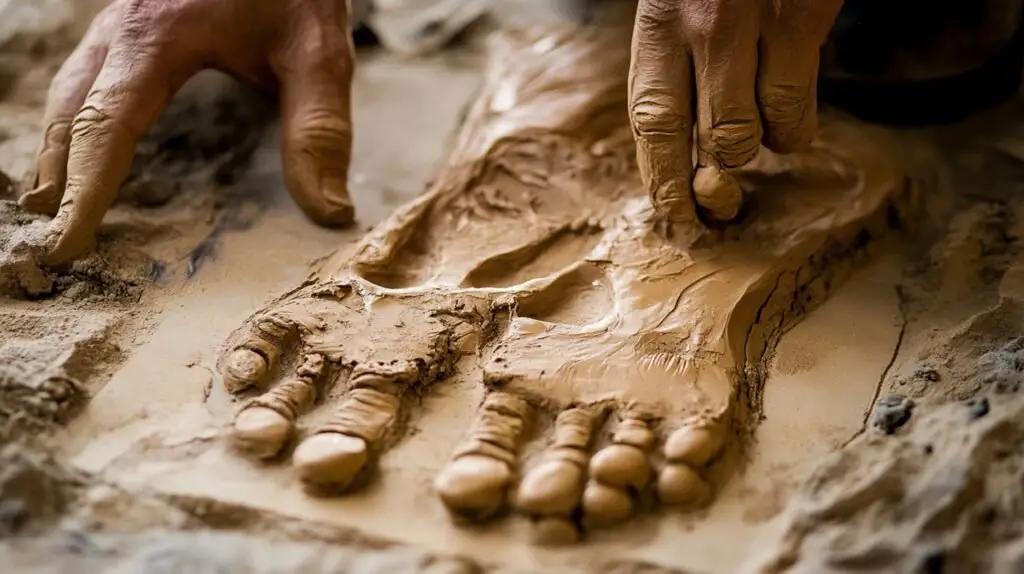
One of the coolest things about White Sands? It’s got some seriously old stories to tell through ancient footprints. We’re talking about human tracks dating back 21,000 to 23,000 years ago (Wikipedia).
In addition to ancient human tracks, you’ve got prints from giant ground sloths and mammoths. It’s like stepping into a prehistoric snapshot, offering clues about life in the Tularosa Basin eons ago.
Dig archaeology and ancient history? Visiting these footprints is a time-traveling adventure. Delve into more about this backstory here.
Wanna plan your trip right? Scope out the park map, check out tours, and get park hours.
